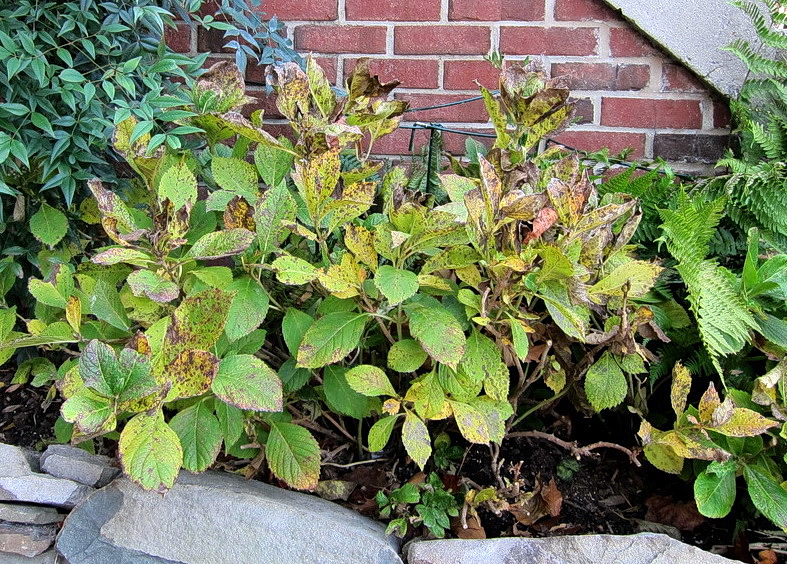Our Hydrangea Leaves Turning Yellow Diaries
Wiki Article
The 15-Second Trick For Hydrangea Leaves Turning Yellow
Table of ContentsTop Guidelines Of Hydrangea Leaves Turning YellowGetting The Hydrangea Leaves Turning Yellow To WorkFacts About Hydrangea Leaves Turning Yellow Revealed4 Easy Facts About Hydrangea Leaves Turning Yellow Explained
Hydrangea plants are recognized for their beautiful flowers, but sometimes their fallen leaves can transform yellow. This is normally a sign that something is wrong and the plant needs your aid. There are several possible reasons for yellow fallen leaves on Hydrangeas, and luckily a lot of them are simple to take care of. Here we'll cover one of the most common root causes of Hydrangea leaves turning yellow and exactly how to fix them.Nevertheless, Hydrangea leaves turning yellow can be a cause for concern. There are several reasons that Hydrangea leaves turn yellow, and a lot of them are simple to take care of. Let's look at one of the most usual reasons Hydrangea leaves turn yellow and how to repair them. Hydrangea leaves normally transform yellow when the plant is overwatered.
When the roots of a plant are submerged in water for lengthy periods, they begin to stifle and rot. This process cuts off the origins' oxygen supply, triggering the leaves to transform yellow and at some point pass away. Overwatering can likewise lead to various other issues such as leaf decrease, root damage, and fungal development.
If you think your Hydrangea is overwatered, the most effective remedy is to allow the soil dry out entirely before watering once more. It's also an excellent concept to examine the water drainage of your pot or yard bed and make certain that water is not merging around the plant's roots. Hydrangea plants require well-drained dirt to thrive.
Everything about Hydrangea Leaves Turning Yellow
You must also make certain that you are not sprinkling your Hydrangea frequently. Watering when a week ought to suffice, and more frequently if the climate is hot and completely dry. Hydrangea leaves can likewise turn yellow if the plant is not getting adequate water. This takes place when the plant does not get adequate water, and the dirt begins to dry out.This is referred to as "fertilizer melt," It happens when the plant's origins are exposed to excessive fertilizer. The origins can't soak up all page of the nutrients and come to be harmed. This damages creates the leaves to transform yellow and eventually die. Other indications of plant food melt include brown or yellow leaves, wilting, and stunted growth.
This will certainly help eliminate any excess plant food from the roots of the plant. It's additionally a great concept to decrease the amount of fertilizer you are utilizing.
Some Known Factual Statements About Hydrangea Leaves Turning Yellow

If your Hydrangea is ravaged with pests, treating the plant with neem or gardening oil is the ideal option. It's also good to eliminate any type of damaged leaves from the plant (Hydrangea Leaves Turning Yellow).
Hydrangea leaves can also you can check here transform yellow More Bonuses if the temperature level worries the plant. The fallen leaves of the plant will transform yellow and begin to go down off.
If the temperature emphasizes your Hydrangea, you need to relocate the plant to a place where it will be secured from the severe cold or heat. You can also try to offer the plant with some partial shade if exposed to direct sunlight. You can additionally attempt adding compost around the plant base to assist manage the temperature.
Fascination About Hydrangea Leaves Turning Yellow
The leaves can additionally turn yellow if the Hydrangea plant has root rot. This is usually brought on by overwatering or inadequate drainage. When the plant's origins are submerged in water for too long, they begin to rot. Among one of the most common origin rot symptoms is yellowing leaves, as the fungus avoids the roots from absorbing nutrients from the soil.Other indicators of origin rot consist of stunted development, wilting, and leaf decline. Check the origins of your Hydrangea if it has root rot. If they are black or brownish, then they are most likely rotten. If some healthy and balanced origins are left, you can try to conserve the plant by replanting it in a new pot with fresh soil.
Water the plant thoroughly, seeing to it not to overwater it. If your Hydrangea is heavily impacted by root rot, beginning with a new plant is best. Natural reasons can likewise create yellow hydrangea leaves. The most usual cause is the plant's age. As Hydrangeas age, their fallen leaves will gradually transform yellow and brownish prior to dropping off the plant.
You can aid the plant by guaranteeing it is obtaining adequate water and nutrients. You can additionally mulch around the plant base to aid it preserve wetness. There are numerous reasons that hydrangea leaves may transform yellow and diminish. Hydrangea Leaves Turning Yellow. One opportunity is that the plant is not getting sufficient water.
Report this wiki page